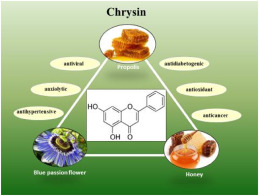当前位置:
X-MOL 学术
›
Phytochemistry
›
论文详情
Our official English website, www.x-mol.net, welcomes your
feedback! (Note: you will need to create a separate account there.)
Chrysin: Sources, beneficial pharmacological activities, and molecular mechanism of action
Phytochemistry ( IF 3.2 ) Pub Date : 2018-01-01 , DOI: 10.1016/j.phytochem.2017.09.016 Renuka Mani , Vijayakumar Natesan
Phytochemistry ( IF 3.2 ) Pub Date : 2018-01-01 , DOI: 10.1016/j.phytochem.2017.09.016 Renuka Mani , Vijayakumar Natesan

|
In recent years, public and scientific interest in plant flavonoids has tremendously increased because of their postulated health benefits. This review was mainly focuses on the flavone chrysin (5,7-dihydroxyflavone), which occurs naturally in many plants, honey, and propolis. A number of in vitro and in vivo studies have revealed the therapeutic effects of chrysin against various diseases. In general, chrysin exhibits many biological activities and pharmacological effects, including antioxidant, anti-inflammatory, anticancer, and antiviral activities. Moreover, many studies have reported on the bioavailability of chrysin. Because of its compromised bioavailability and enhanced protein stability, chrysin solid lipid nanoparticle (SLN) synthesis avoids proteolytic degradation and sustained release of drug delivery. To clarify the mechanism of action of chrysin, researchers have investigated the structural binding relationship of chrysin through the docking computation method.
中文翻译:

白杨素:来源、有益的药理活性和分子作用机制
近年来,由于植物类黄酮对健康有益,公众和科学界对它们的兴趣大大增加。这篇综述主要关注黄酮白杨素(5,7-二羟基黄酮),它天然存在于许多植物、蜂蜜和蜂胶中。许多体外和体内研究揭示了白杨素对各种疾病的治疗作用。一般来说,白杨素表现出许多生物活性和药理作用,包括抗氧化、抗炎、抗癌和抗病毒活性。此外,许多研究报告了白杨素的生物利用度。由于其生物利用度受损和蛋白质稳定性增强,白杨素固体脂质纳米颗粒 (SLN) 合成避免了蛋白水解降解和药物递送的持续释放。
更新日期:2018-01-01
中文翻译:

白杨素:来源、有益的药理活性和分子作用机制
近年来,由于植物类黄酮对健康有益,公众和科学界对它们的兴趣大大增加。这篇综述主要关注黄酮白杨素(5,7-二羟基黄酮),它天然存在于许多植物、蜂蜜和蜂胶中。许多体外和体内研究揭示了白杨素对各种疾病的治疗作用。一般来说,白杨素表现出许多生物活性和药理作用,包括抗氧化、抗炎、抗癌和抗病毒活性。此外,许多研究报告了白杨素的生物利用度。由于其生物利用度受损和蛋白质稳定性增强,白杨素固体脂质纳米颗粒 (SLN) 合成避免了蛋白水解降解和药物递送的持续释放。











































 京公网安备 11010802027423号
京公网安备 11010802027423号